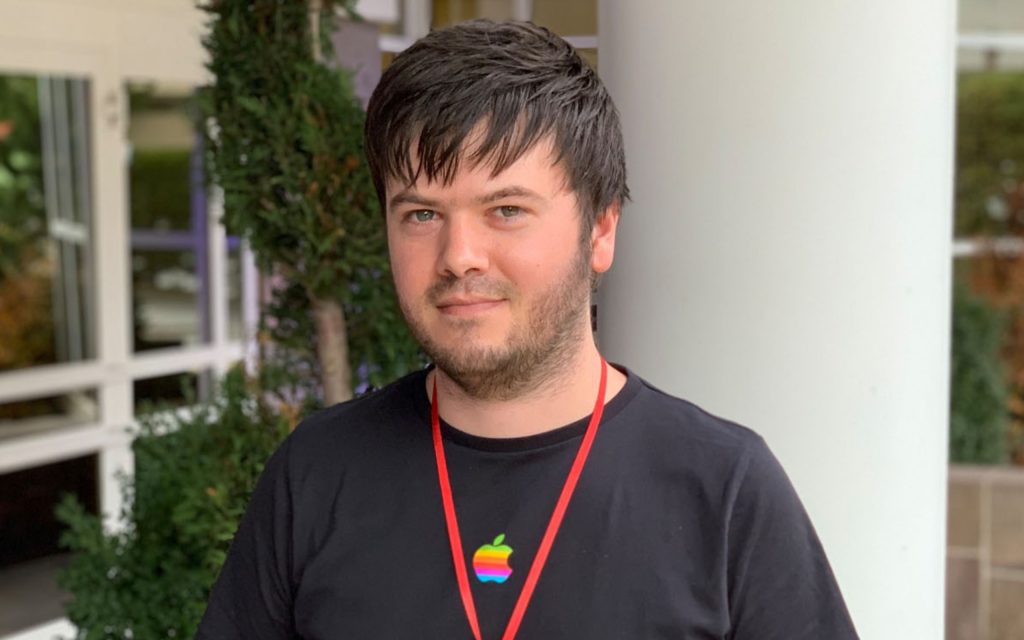On Oct. 2, Brazilian software developer Guilherme Rambo found evidence of unannounced third-generation AirPods hidden within a new beta of iOS, Apple’s mobile operating system. Digging through a newly released build of iOS 13.2, he discovered a low-resolution icon depicting the earbuds, and new options for noise cancelling. He immediately shared his findings on 9to5Mac, a well-known Apple blog. From there, they were republished across the internet at tech sites like The Verge and BGR, as well as at establishment outlets like the International Business Times, where writer Julio Chachila called him a “super sleuth,” and Forbes, where tech reporter David Phelan hailed him as “a modern day Sherlock.”
“It’s funny,” Rambo said in an Oct. 8 Skype interview from his home in Florianopolis, Brazil, his black hair deliberately swept forward atop his stubbled face. “Every website has a way to describe me. I have this collection of adjectives they’ve used for me.”
The initial leak was confirmed weeks later, when Apple announced the AirPods Pro on Oct. 28. More than mere rumor, these images were substantiated by their source — Apple’s own software — through Rambo’s careful detective work.
At the heart of the tech news cycle, rumors and leaks about new devices snowball into stories. Rambo is frequently the source of these glimpses into the future. As a professional leaker, he digs through early beta versions of Apple’s software, finding accidental hints of forthcoming iPhones, iPads and other hardware. Before the company dazzles with grand, orchestrated unveilings, and before mainstream outlets like Bloomberg and The Wall Street Journal publish exhaustive rumor roundups, Rambo finds clues embedded in lines of code.
Growing up in southern Brazil, Rambo developed a passion for reverse engineering. “My dad used to work with electronics repairs, TVs and all sorts of home electronics,” he said. “So I grew up watching him disassemble stuff and seeing how it worked and what was broken and fixing it. I guess that kind of burned this interest about how things work in my mind.” When his family purchased a home computer, he began to study programming — a skill that would serve him well as a developer.
Today, Rambo spends his days working on a variety of software. He develops his own apps — AirBuddy, an AirPods utility for the Mac, and Chibi Studio, an art app for fans of anime. He also codes for Piexe Urbano, a Brazilian tech company working on an upcoming mobile payment system. Although these apps are his main source of income, the lure of finding and sharing the latest information keeps him on the hunt for leaks. “It’s like if you found a piece of gold through lots and lots of mining,” he said. “It feels really good.”
To find these elusive scraps of information, Rambo uses a proprietary process he developed. A system he designed monitors Apple’s servers for updates, and extracts all the data — images, audio files, code — buried in the latest version. “Then I compare it with the information I gathered from the previous build to see what changed,” he said. “Then I can do a deeper analysis of specific apps or subsystems. And it’s mainly a manual thing because I need to look at the changes and interpret them.”
In 2017, as rumors swirled about a potential iPhone redesign, Rambo discovered a tiny icon that would make him famous in tech circles. Apple had just put out beta firmware for its upcoming HomePod smart speaker. Rambo and fellow developer Filipe Espósito quickly downloaded the firmware to further explore its contents. “At the time, I thought it would have nothing interesting beyond what had already been published… so I stopped looking for more info,” said Espósito. Rambo, however, kept looking and eventually found an outline of what would become the iPhone X’s distinctive camera notch, confirming a full year of design speculation. The leak, grounded in Apple’s own firmware, spread across social media and tech news sites.
“As for the snowball effect after that, it can probably only really happen with the iPhone,” Ben Newcombe, a developer and friend of Rambo, said. “The glyph was probably perfect for spreading: It confirmed all the juiciest rumors and still left the finer details to the imagination.”
While Newcombe and Rambo joked about the purported authenticity of rumors and conversed about his discoveries, they were also influencing the news cycle. Rambo’s name started appearing in ledes across tech outlets like Mashable and Gizmodo. Even The Guardian covered the story, citing Rambo and sharing the icon he had unearthed. “This screenshot of our text messages ended up on mainstream news sites,” Newcombe said. “Gui and I were just a pair of dorks who enjoyed the armchair spectating of it.”
Marcus Mendes, a tech podcaster and a close friend of Rambo, remembered the pride he felt when a fellow Brazilian made it into the news. “Especially for us here in Brazil, you know, it’s sort of like this soccer team,” he said. “He became the news, especially here, and not just what he had leaked, but the fact that he was from here.” And, Mendes said, the impact of the leak spread far beyond the tech world. “Even my parents were like, ‘Oh, did you see that Apple has released an image?’ It wasn’t Apple, it was Rambo, but my parents know about it now, you know?”
After the hype around Rambo’s iPhone X discovery settled, Seth Weintraub, owner of 9to5Mac, reached out to him with a job offer. “He seemed like a code whisperer,” Weintraub said. “He became a developer star on Twitter. I reached out to him there.” Now, Rambo gets paid by 9to5Mac to report on the information he uncovers.
In spite of his newfound star status, Mendes said Rambo maintains his humility and willingness to help others. “He has been… using this attention that he got from this (his leaks) for the good,” he said. On Twitter, small developers working on their first projects reach out to Rambo about their work. He often shares their apps to his audience or helps them improve. “And he didn’t really have to do that, but he’s been consistently doing it,” Mendes said.
Rambo said he has never been officially contacted by Apple about his leaks, but the company has gotten smarter about protecting its data. After he found hidden press images of the iPhone XS and Apple Watch Series 4 on Apple’s website, its web developers began adding random characters to file names, preventing a similar leak from happening again.
His leaks do have a tangible negative impact on Apple. In 2017, when his famous iPhone X leak broke, Apple CEO Tim Cook blamed slowing iPhone sales on early speculation about the next model. “We’re seeing what we believe to be a pause in purchases on iPhone, which we believe are due to the earlier and much more frequent reports about future iPhones,” he said in a conference call with investors.
However, the excitement that builds from leaking can be positive. David Hyman is the former CEO of MOG, the company that eventually became Apple Music. Leaks are “a double-edged sword,” he said. Although they may stifle current sales, the anticipation that leaks build may make up for it. “If someone is leaking on you, you’ve already made it,” he said.
Allen St. John, a tech journalist at Consumer Reports, said leaks are an undisputed positive. “There’s pent-up demand for information about Apple products,” he said. “And honestly, it only benefits the company when consumers get a ‘sneak preview’ of the form or features of an upcoming phone or laptop.”
Rambo does not see his work as undermining the company. “I don’t think it steals their thunder,” he said. “I never have the story. I never have the why. Apple loves to sell you the why — why you’d want this product, why this product is good. They usually don’t sell you the what, like this has ‘x’ gigabytes of RAM…which is what most companies do. They sell you a story and they sell you an experience and I think that part is all theirs.”




Comments are closed.